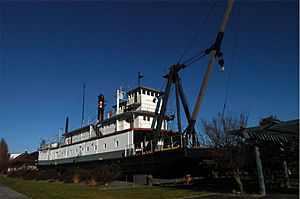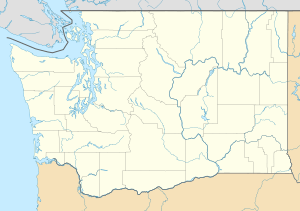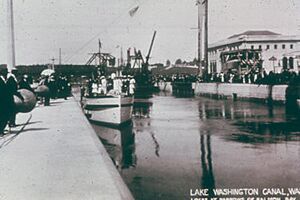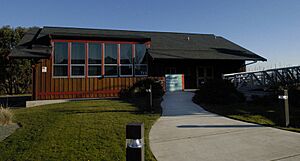W. T. Preston facts for kids

W. T. Preston in her permanent dry dock in Anacortes, Washington.
|
|
| History | |
|---|---|
| Launched | 1929 |
| Out of service | 1981 |
| Refit | 1939 (re-hulled) |
| Status | Museum ship |
| General characteristics | |
| Tonnage | 490 Gross Tons |
| Length | 163 ft 6 in (49.83 m) |
| Beam | 34 ft 8.5 in (10.579 m) |
| Draft | 3 ft 8 in (1.12 m) |
| Installed power |
|
| Propulsion | Sternwheel |
| Speed | 9 knots (17 km/h; 10 mph) (cruise) 12 knots (22 km/h; 14 mph) (max) |
|
W. T. Preston (snagboat)
|
|
| Location | Anacortes waterfront, R Avenue, at foot of 7th Street, Anacortes, Washington |
| Built | 1929 (re-hulled in 1939) |
| Architect | Lake Union Drydock Co. |
| Architectural style | Welded Barge Hull, Wooden Super Structure, Sternwheeler |
| NRHP reference No. | 72001270 |
| Significant dates | |
| Added to NRHP | 16 March 1972 |
| Designated NHL | 5 May 1989 |
The W. T. Preston is a special kind of boat called a snagboat. It's a sternwheeler, which means it's powered by a large paddle wheel at its back. For many years, this boat worked like a river janitor, clearing away logs and other junk that blocked rivers in the Puget Sound area of Washington state.
Today, the W. T. Preston is a museum ship and the main attraction at the Snagboat Heritage Center in Anacortes, Washington. It's so important to American history that it was named a National Historic Landmark in 1989. It is one of only two snagboats of its kind left that were built by the United States Army Corps of Engineers.
Contents
History of the River Cleaner
The W. T. Preston had a very important job. It sailed in the waters from Olympia to Blaine, including major rivers like the Skagit, Stillaguamish, and Snohomish.
Why Was a Snagboat Needed?
When dead trees fell into the rivers and floated out to Puget Sound, they often became dangerous hazards. Some would get waterlogged and float just under the surface. These were called "deadheads," and they could easily poke holes in the wooden ships used at the time.
To make river travel safe for trade and transportation, the U.S. government started building snagboats to pull these dangers out of the water. The W. T. Preston was built in 1929 and named after a respected engineer who worked for the Army Corps of Engineers.
Built from an Older Ship
An interesting fact about the W. T. Preston is that it was partly made from recycled materials. It used the powerful steam engines and other machinery from an older snagboat, the 1914 Swinomish. Reusing parts was common because the steam engines were built to be very strong and often lasted longer than the wooden boat hulls.
This was similar to another snagboat, the Samson V in Canada. When it was built in 1937, it used engines, a crane, and a winch from four older boats. Like the W. T. Preston, the Samson V was the last steam-powered paddlewheeler working in its country when it retired.
A New Body for an Old Workhorse
The first W. T. Preston had a wooden hull. By 1939, it was time for an upgrade. The Army Corps of Engineers built a brand-new, stronger hull out of welded steel. They then moved the old boat's cabin, smokestack, paddle wheel, and engines onto the new steel body.
Over the years, the W. T. Preston took on new jobs. As boats and trucks became more common for moving goods, the rivers were used less for transport. The snagboat then started to do other tasks, like dredging (scooping mud from the river bottom), fighting fires, and general repair work. It even helped recover a sunken military bomber and several cars from the water!
The Army Corps of Engineers operated the boat for over 40 years before it was retired in 1981. A modern boat named the Puget took over its job and still works out of the same dock today.
Snagboat Heritage Center
The W. T. Preston is now on permanent display on land in Anacortes, Washington. You can visit the boat, which is now a floating museum.
In 2005, the Snagboat Heritage Center was built next to the ship. This building is an interpretive center where you can learn all about the history of snagboats. It has cool exhibits with old tools, models of the boats, maps, and stories about how these amazing vessels kept the rivers safe for everyone.
See also
- Montgomery Snagboat
- Historic preservation





